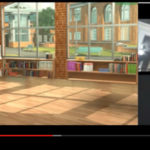Saint Leo University’s master’s degree programs in Education and Educational Specialist both have qualitative research courses that students find challenging. The courses are especially challenging for those students enrolled in the online programs where they do not have the opportunity to watch how others conduct research. Videos can help bridge this gap, but students are not able to interact with the videos or test ideas in a safe setting.
Enter
Mursion, a company that provides pre-made mixed reality simulations that can be customized to meet the learning needs of business and education. The environments range from a classroom of about half a dozen middle-school students, to individual conversations with either a child or an adult. These are virtual, immersive training simulations that use mixed-reality avatars and live actors to deliver simulations of challenging classroom situations our students will encounter as educators.
To get started, the instructor or content developer first picks a type of simulation from the offerings, such as a classroom of sixth graders. That person then determines how it will be customized to their own needs. This information is conveyed to a simulation specialist at Mursion who tailors the simulation to its use. The simulation specialist builds the simulation in collaboration with the course instructor. The more specific the instructor is, the more realistic the simulation environment. The simulation specialist needs to have knowledge about the desired previous experiences of the student avatars, the persona they could adapt, their content knowledge, and their level of resistance or compliance.
At the agreed upon time, the participants connect with the Mursion environment by accessing the designed Zoom room. Through the use of the grad student’s computer camera and microphone, he or she interacts directly with the avatars, as if speaking in front of a classroom. The avatars are controlled by the simulation specialist responding to student input according to profiles of each avatar. This person uses a voice changer to respond to the student instructor, as well as control the mannerisms and actions of the avatars. The responses might include “push back” from students, such as complaints about an activity. While the avatars respond to the grad students, students respond to avatars and can ask questions of them. One participant compared the interaction to “having a conversation or teaching a small group of students.”

A second important element of the simulation is peer feedback. While the student is going through the simulation, other students in class are watching on the same video to see how avatars respond to the student’s words and actions, and they need to be ready to offer feedback. The student leading the simulation can say “pause classroom” at any point in the simulation to ask questions of peer students and the instructor. During this time, the student looks to the faculty member leading the session and his/her peers for suggestions to make lesson more successful. Then with the cue, “Resume classroom,” the simulation specialist brings the avatars back and the action is resumed.
Because it’s not always easy for online students to coordinate their schedules for a synchronous meeting, we made attending the live simulation optional. Those not able to attend live were required to watch the recording and engage in reflective discussion board questions with the other class members.
Although we currently rely on Mursion to provide the simulation specialist, St. Leo recently purchased a site license and we plan to use our own simulation specialist. As more and more universities adopt these simulations, they will likely be adding simulation specialists to their instructional design crew, allowing for simulations to be adopted across a variety of courses. A department might even train graduate students to develop and/or manage simulations for their courses. Companies like Mursion, simSchool, Simiosys, and others offer simple ways to create simulations from templates that do not require technical expertise. Simulations could be the wave of the future.
Holly Atkins and Lin Carver are associate professors of education at Saint Leo University.




